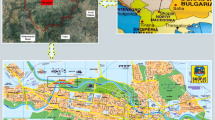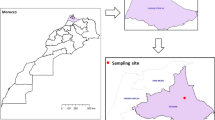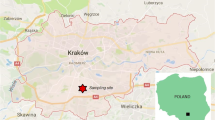Abstract
Samples of airborne particulate matter (PM2.5) were collected at a site in Lahore, Pakistan from November 2005 to January 2006. A total of 129 samples were collected using an Andersen Reference Ambient Air Sampler 2.5-400 sampler and analyzed for major ions, trace metals, and organic and elemental carbon concentrations. The data set was then analyzed by positive matrix factorization (PMF) to identify the possible sources of the atmospheric PM collected in this urban area. Six factors reproduced the PM2.5 sample compositions with meaningful physical interpretation of the resolved factors. The sources included secondary PM, diesel emissions, biomass burning, coal combustion, two-stroke vehicle exhaust, and industrial sources. Diesel and two-stroke vehicles contributed about 36%, biomass burning about 15%, and coal combustion sources around 13% of the PM2.5 mass. Nearly two thirds of the PM2.5 mass is carbonaceous material. Secondary particles contributed about 30% of PM2.5 mass. The conditional probability function (CPF) was then used to help identify likely locations of the sources present in this area. CPF analysis point to the east and northeast, which are directions of urban and industrial areas located across the border near Amritsar, India as the most probable source for high PM2.5 concentration from diesel and two-stroke vehicles exhaust in Lahore. Analysis of those days within three different ranges of PM2.5 concentration shows that most of the measured high PM2.5 mass concentrations were driven by diesel and two-stroke vehicle emissions including the associated primary sulfate. The use of the potential source contribution function (PSCF) to find the source locations of regionally transported particles is inapplicable in situations when high PM2.5 concentrations are dominated by local sources and local meteorology.











Similar content being viewed by others
References
Ashbaugh, L. L., Malm, W. C., & Sadeh, W. Z. (1985). A residence time probability analysis of sulfur concentrations at Grand Canyon National Park. Atmospheric Environment, 19, 1263–1270.
Barletta, B., Meinardi, S., Simpson, I. J., Khwaja, H. A., Blake, D. R., & Rowland, F. S. (2002). Mixing ratios of volatile organic compounds (VOCs) in the atmosphere of Karachi, Pakistan. Atmospheric Environment, 36(21), 3429–3443.
Bhanuprasad, S. G., Venkataraman, C., & Bhushan, M. (2008). Positive matrix factorization and trajectory modelling for source identification: A new look at Indian Ocean Experiment ship observations. Atmospheric Environment, 42(20), 4836–4852.
Birch, M. E., & Cary, R. A. (1996). Elemental carbon-based method for monitoring occupational exposures to particulate diesel exhaust. Aerosol Science and Technology, 25(3), 221–241.
Biswas, K. F., Ghauri, B. M., & Husain, L. (2008). Gaseous and aerosol pollutants during fog and clear episodes in South Asian urban atmosphere. Atmospheric Environment, 42(33), 7775–7785.
Chueinta, W., Hopke, P. K., & Paatero, P. (2000). Investigation of sources of atmospheric aerosol at urban and suburban residential areas in Thailand by positive matrix factorization. Atmospheric Environment, 34, 3319–3329.
Echalar, F., Gaudichet, A., Cachier, H., & Artaxo, P. (1995). Aerosol emissions by tropical forest and savanna biomass burning: Characteristic trace elements and fluxes. Geophysical Research Letters, 22(22), 3039–3042.
Evans, M. C., Campbell, S. W., Bhethanabotla, V., & Poor, N. D. (2004). Effect of sea salt and calcium carbonate interactions with nitric acid on the direct dry deposition of nitrogen to Tampa Bay, Florida. Atmospheric Environment, 38(29), 4847–4858.
Faiz, A., & Gautam, S. (2004). Technical and policy options for reducing emissions from 2-stroke engine vehicles in Asia. International Journal of Vehicle Design, 34(1), 1–11.
Faiz, A., & Sturm, P. J. (2000). New directions: Air pollution and road traffic in developing countries. Atmospheric Environment, 34(27), 4745–4746.
Habib, G., Venkataraman, C., Shrivastava, M., Banerjee, R., Stehr, J. W., & Dickerson, R. R. (2004). New methodology for estimating biofuel consumption for cooking: Atmospheric emissions of black carbon and sulfur dioxide from India. Global Biogeochemical Cycles, 18, GB3007.
Harrison, R. M., Smith, D. J. T., Piou, C. A., & Castro, L. M. (1997). Comparative receptor modelling study of airborne particulate pollutants in Birmingham (United Kingdom), Coimbra (Portugal) and Lahore (Pakistan). Atmospheric Environment, 31(20), 3309–3321.
Hopke, P. K. (2009). Contemporary threats and air pollution. Atmospheric Environment, 43(1), 87–93.
Hopke, P. K., Barrie, L. A., Li, S. M., Cheng, M. D., Li, C., & Xie, Y. (1995). Possible sources and preferred pathways for biogenic and non-sea-salt sulfur for the high Arctic. Journal of Geophysical Research, 100(D8), 16595–16603.
Husain, L., Dutkiewicz, V. A., Khan, A. J., & Ghauri, B. M. (2007). Characterization of carbonaceous aerosols in urban air. Atmospheric Environment, 41(32), 6872–6883.
Hussain, K., Riffat, R., Shaukat, A., & Siddiqui, M. (1990). A study of suspended particulate matter in Lahore (Pakistan). Advances in Atmospheric Sciences, 7(2), 178–185.
Kim, E., Hopke, P. K., & Edgerton, E. S. (2003). Source identification of Atlanta aerosol by positive matrix factorization. Journal of the Air & Waste Management Association, 53(6), 731–739.
Lee, E., Chan, C. K., & Paatero, P. (1999). Application of positive matrix factorization in source apportionment of particulate pollutants in Hong Kong. Atmospheric Environment, 33(19), 3201–3212.
Li, J., Pósfai, M., Hobbs, P. V., & Buseck, P. R. (2003). Individual aerosol particles from biomass burning in southern Africa: 2, compositions and aging of inorganic particles. Journal of Geophysical Research, 108(D13), 8484. doi:10.1029/2002JD002310.
Marmur, A., Unal, A., Mulholland, J. A., & Russell, A. G. (2005). Optimization-based source apportionment of PM2.5 incorporating gas-to-particle ratios. Environmental Science & Technology, 39(9), 3245–3254.
Mehta, B., Venkataraman, C., Bhushan, M., & Tripathi, S. N. (2009). Identification of sources affecting fog formation using receptor modeling approaches and inventory estimates of sectoral emissions. Atmospheric Environment, 43(6), 1288–1295.
Mészáros, A. (1978). On the concentration and size distribution of atmospheric sulfate particles under rural conditions. Atmospheric Environment, 12(12), 2425–2428.
Nguyen, M.-T., Jamka, A. J., Cazar, R. A., & Tao, F.-M. (1997). Structure and stability of the nitric acid–ammonia complex in the gas phase and in water. Journal of Chemical Physics, 106(21), 8710–8717.
Paatero, P. (1997). Least squares formulation of robust nonnegative factor analysis. Chemometrics and Intelligent Laboratory Systems, 37, 23–35.
Paatero, P., & Hopke, P. K. (2003). Discarding or downweighting high-noise variables in factor analytic models. Analytica Chimica Acta, 490, 277–289.
Paatero, P., Hopke, P. K., Song, X. H., Ramadan, Z. (2002). Understanding and controlling rotations in factor analytic models, Chemometrics and Intelligent Laboratory Systems 60, 253–264.
Parekh, P. P., Khwaja, H. A., Khan, A. R., Naqvi, R. R., Malik, A., & Shah, S. A. (2001). Ambient air quality of two metropolitan cities of Pakistan and its health implications. Atmospheric Environment, 35(34), 5971–5978.
Polissar, A. V., Hopke, P. K., Paatero, P., Malm, W. C., & Sisler, J. F. (1998). Atmospheric aerosol over Alaska 1. Elemental composition and sources. Journal of Geophysical Research, 103(D15), 19045–19057.
Qadir, M. A., & Zaidi, J. H. (2006). Characteristics of the aerosol particulates in the atmosphere in an urban environment at Faisalabad, Pakistan. Journal of Radioanalytical and Nuclear Chemistry, 267(3), 545–550.
Quinn, P. K., Coffman, D. J., Bates, T. S., Miller, T. L., Johnson, J. E., Welton, E. J., et al. (2002). Aerosol optical properties during INDOEX 1999: Means, variability, and controlling factors. Journal of Geophysical Research, 107, 8020.
Ramanathan, V., & Feng, Y. (2009). Air pollution, greenhouse gases and climate change: Global and regional perspectives. Atmospheric Environment, 43(1), 37–50.
Reddy, M. S., & Venkataraman, C. (2002). Inventory of aerosol and sulphur dioxide emissions from India: I—fossil fuel combustion. Atmospheric Environment, 36(4), 677–697.
Rolph, G. D. (2003). Real-time environmental applications and display system (READY) website. NOAA Air Resources Laboratory. Retrieved from (http://www.arl.noaa.gov/ready/hysplit4.html).
Seinfeld, J. H., & Pandis, S. N. (1998). Atmospheric chemistry and physics: From air pollution to climate change. New York: Wiley.
Smith, D. J. T., Harrison, R. M., Luhana, L., Pio, C. A., Castro, L. M., Tariq, M. N., et al. (1996). Concentrations of particulate airborne polycyclic aromatic hydrocarbons and metals collected in Lahore, Pakistan. Atmospheric Environment, 30(23), 4031–4040.
Venkataraman, C., Habib, G., Eiguren-Fernandez, A., Miguel, A. H., & Friedlander, S. K. (2005). Residential biofuels in south Asia: Carbonaceous aerosol emissions and climate impact. Science, 307(5714), 1454.
Wahid, A. (2006). Productivity losses in barley attributable to ambient atmospheric pollutants in Pakistan. Atmospheric Environment, 40(28), 5342–5354.
WHO and UNEP. (1992). Urban air pollution in megacities of the world. Oxford: Blackwell.
Zeng, Y., & Hopke, P. K. (1989). A study of the sources of acid precipitation in Ontario, Canada. Atmospheric Environment, 23(7), 1499–1509.
Acknowledgements
This work was supported in part by a grant from the U.S. National Science Foundation, ATM0503850. One of us (LH) is grateful to the United Nations Development Program and the National Talent Pool for a travel grant to conduct the field campaign in Lahore and the National Talent Pool, Ministry of Labour, Government of Pakistan. We thank Zulfiqar Ali, Salim Khan, M. Mannan, Akhtar Nawaz, and Adil Khan.
Author information
Authors and Affiliations
Corresponding author
Rights and permissions
About this article
Cite this article
Raja, S., Biswas, K.F., Husain, L. et al. Source Apportionment of the Atmospheric Aerosol in Lahore, Pakistan. Water Air Soil Pollut 208, 43–57 (2010). https://doi.org/10.1007/s11270-009-0148-z
Received:
Accepted:
Published:
Issue Date:
DOI: https://doi.org/10.1007/s11270-009-0148-z




